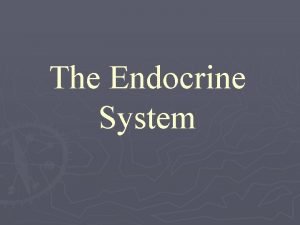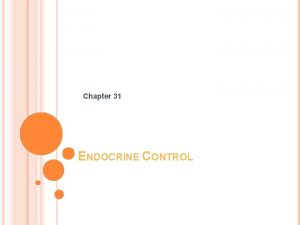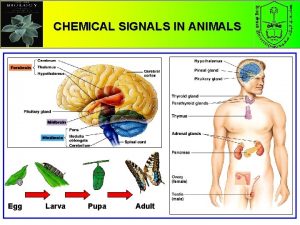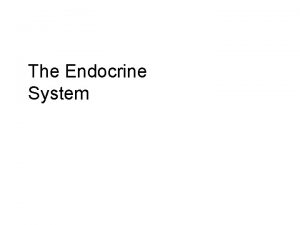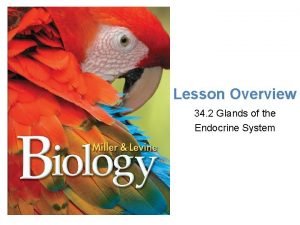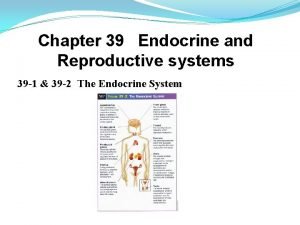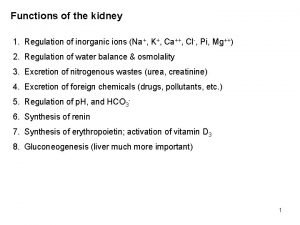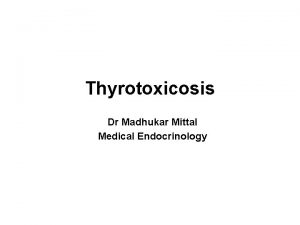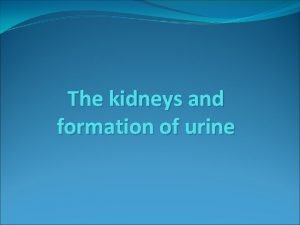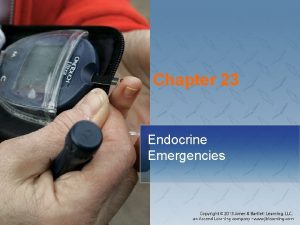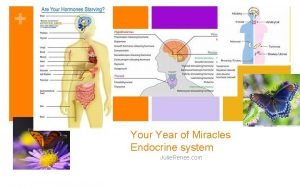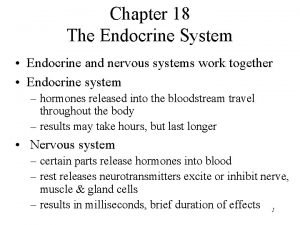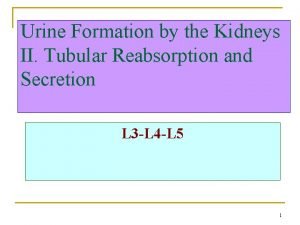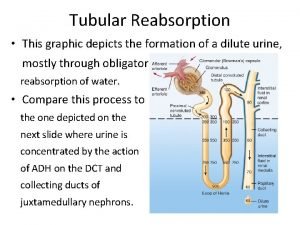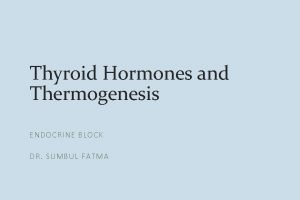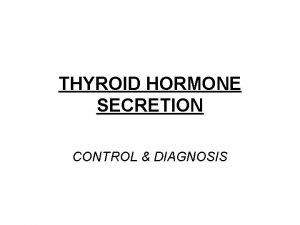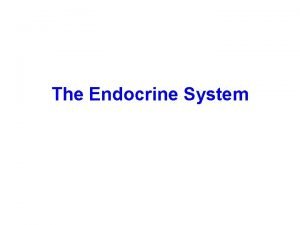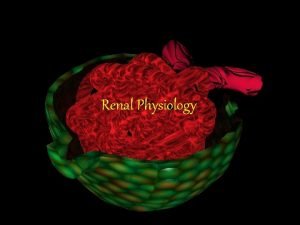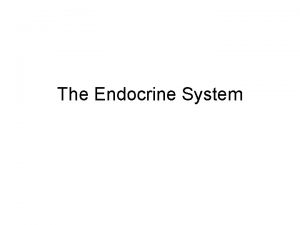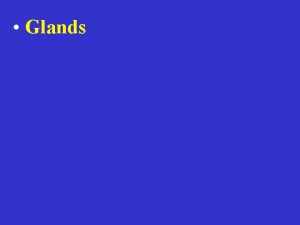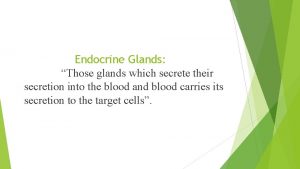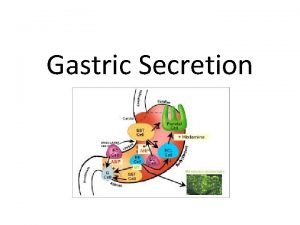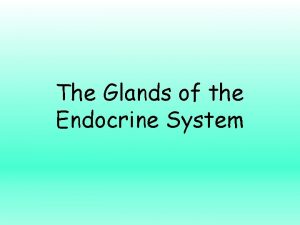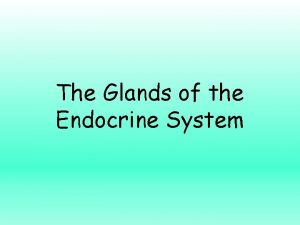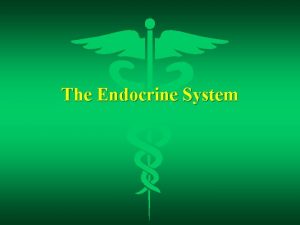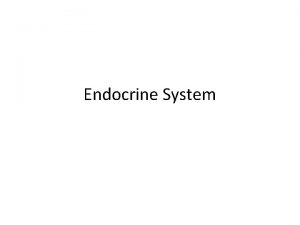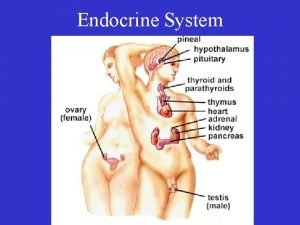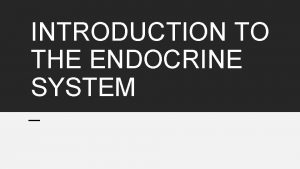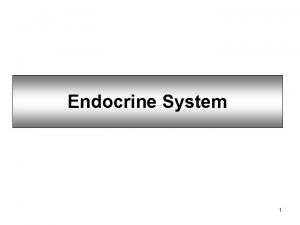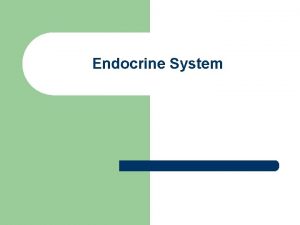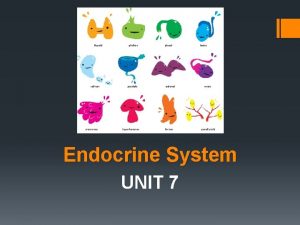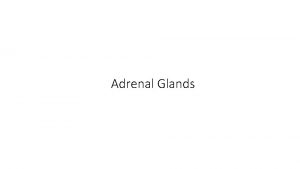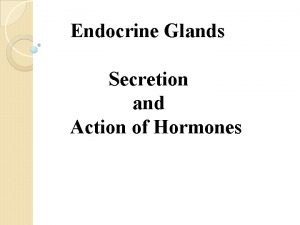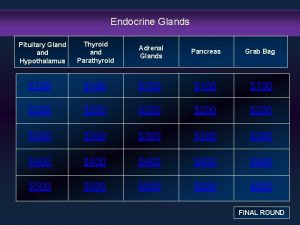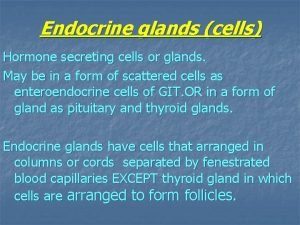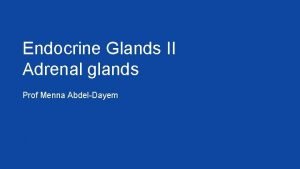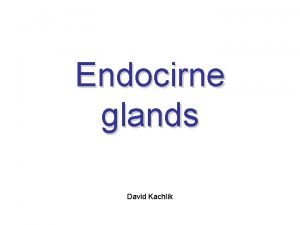Chapter 11 Part 1 Endocrine Glands Secretion and


















![Effects of [Hormone] on Tissue Response • [Hormone] in blood reflects the rate of Effects of [Hormone] on Tissue Response • [Hormone] in blood reflects the rate of](https://slidetodoc.com/presentation_image_h/18003012686ce1be5f250f0c3cbea5f7/image-19.jpg)














![Effects of [Hormone] on Tissue Response (continued) • Priming effect (upregulation): – Increase number Effects of [Hormone] on Tissue Response (continued) • Priming effect (upregulation): – Increase number](https://slidetodoc.com/presentation_image_h/18003012686ce1be5f250f0c3cbea5f7/image-34.jpg)

- Slides: 35

Chapter 11 Part 1 Endocrine Glands: Secretion and Action of Hormones

Classic Definition of a Hormone • Hormone - Chemical messenger produced by a ductless gland or tissue and carried in the blood/lymph to a target organ where it effects a change in cellular activity. Effector Cell 1 Target Cell 2 Capillary

Endocrine Glands Hypothalamus Adrenal Gland Ovary Kidney Pituitary Located at base of brain Thyroid Parathyroid Testis in Male

Higher Centers of Brain Control All Hormonal Functions Cerebrum Hypothalamus Third Ventricle Pineal Body Medulla Oblongata Pituitary Stalk Anterior & Posterior Pituitary Cerebellum

Anatomy of Cow Brain Infundibular Stalk Diaphragma sellae Pituitary Spenoid Bone

Control of Endocrine Gland Function Hypothalamic-Pituitary Interrelationships Secreting neurons: Gn. RH, CRH, TRH, GHRH Hypothalamus Superior Hypophyseal Artery Nerve cells which release peptide hormones: Oxytocin, ADH Hypophyseal Portal Vessels Pituitary Stalk Posterior Pituitary: Anterior Pituitary Adenohypophysis non-neural tissue Release of LH, FSH, ACTH, PRL, GH, TSH Neurohypophysis Nerve endings come directly from hypothalamus Release of Oxytocin or ADH into circulation

Endocrine Glands and Hormones • Secrete biologically active molecules into the blood. – Lack ducts. • Carry hormones to target cells that contain specific receptor proteins for that hormone. • Target cells can respond in a specific fashion. • Different from nervous system – – Nervous system is fast, short-term reactions – Endocrine – longer duration, adaptation response.

Endocrine Glands and Hormones • Neurohormone: (continued) – Specialized neurons that secrete chemicals into the blood rather than synaptic cleft. • Chemical secreted is called neurohormone. • Hormones: – Affect metabolism of target organs. • Help regulate total body metabolism, growth, and reproduction.

Other forms of endocrine action 1) Paracrine - released from effector cell (E) interact with a different target cell (T 1). 2) Autocrine - secreted by E interact with original E cell or similar cell types. 3) Juxtacrine -expressed on surface of E and interacts with target cell (T 2) via direct cell contact. 4) Intracrine - is not secreted by E and interacts with an intercellular receptor. T E E E T

Ectocrine Flehmen • Pheromones: A chemical substance that is liberated by one animal and causes a relatively specific behavior modification in a recipient animal following its chemoreception • Lee-Boot effect: Crowded female mice become anestrous when no males are present. • Bruce effect: A newly mated female mouse will abort if placed with a strange male (not the previous mate). • Dormitory effect: menstrual synchrony in all-females living groups

Common Aspects of Neural and Endocrine Regulation • APs are chemical events produced by diffusion of ions through neuron plasma membrane. • Action of some hormones are accompanied by ion diffusion and electrical changes in the target cell. – Nerve axon boutons release NTs. – Some chemicals are secreted as hormones, and also are NTs. • In order for either a NT or hormone to function in physiological regulation: – Target cell must have specific receptor proteins. – Combination of the regulatory molecule with its receptor proteins must cause a specific sequence of changes. – There must be a mechanism to quickly turn off the action of a regulator.





Most hormones belong to one of 4 structural classes • Peptides & Amines (E, NE % DA) are hyrophilic • Steroids and eicosanoids are hydrophobic

Structural Classes • Amines: – Hormones derived from tyrosine and tryptophan. • NE, Epi, T 4. • Peptides, Polypeptides and Proteins – Polypeptides • Chains of < 100 amino acids in length. – ADH. • Ex: Adrenalcorticotropic Hormone (ACTH) – 39 amino acids – Peptide - Few - Several amino acids • Ex: Gonadotropin Releasing Hormone (Gn. RH) - 10 amino acids • Oxytocin - 8 amino acids – Protein hormones: • Polypeptide chains with > 100 amino acids. – Growth hormone, Insulin, ACTH. – Prolactin - 198 amino acids

Structural Classes • Glycoprotein - Protein hormone with carbohydrate molecules - Some have large amount of sialic acid – FSH - Steroids - Lipids derived from cholesterol – Are lipophilic (fat loving; can diffuse through plasma membrane) hormones. - Ex – testosterone, estradiol, progesteone, and cortisol
![Effects of Hormone on Tissue Response Hormone in blood reflects the rate of Effects of [Hormone] on Tissue Response • [Hormone] in blood reflects the rate of](https://slidetodoc.com/presentation_image_h/18003012686ce1be5f250f0c3cbea5f7/image-19.jpg)
Effects of [Hormone] on Tissue Response • [Hormone] in blood reflects the rate of secretion. • Half-life: – Time required for the blood [hormone] to be reduced to ½ reference level. • Minutes to days. • Normal tissue responses are produced only when [hormone] are present within physiological range. • Varying [hormone] within normal, physiological range can affect the responsiveness of target cells.

Percent of Carbohydrate and Size of Protein Effects Half-Life in Blood Equine Chorionic e. CG % in Blood After Injection Gonadotropin 45% Carbohydrate Human Chorionic Gonadotropin 30% Carbohydrate Gn. RH Oxytocin Follicle Stimulating Hormone 8% Carbohrydrate Luteinizing Hormone little sialic acid Time required to remove or clear half of the dose from the blood

Chemical Classification of Hormones (continued)

Δ 4 Δ 5: Primates, Sheep, Cattle Δ 4: Pigs, rats, mice (Conley and Bird 1997)

Hormone Synthesis • Protein Hormones – Synthesized at ribosomes as large precursor proteins – Preprohomrone converted to prohormone within rough ER – Golgi apparatus – packages prohormone and converts it to hormone – Stored in secretory granules – Upon stimulation – get exocytosis • Requires: – 1. ATP – 2. Ca

The flow of genetic informati on in a typical cell

Anterior Pituitary Hormones Such as LH, FSH and TSH (Thyroid Stimulating Hormone) have Two Chains Alpha - a Beta - b b S S a a chain is identical between FSH, LH and TSH. b chain gives the hormone its specific action. Need both chains together for biological activity

TSH Transcription FSH Translation LH h. CG m. RNA TSH, LH and FSH: Pituitary Glycoprotiens h. CG: placental

Synthesis of Steroid Hormones • Ex: glucocorticoids, mineralocorticoids, sex steroids • Formed from cholesterol – which is used immediately or stored in cell – Type of steroid hormone produced depends on presence of specific enzymes – EX: adrenal cortex cell – contain enzymes needed for production of glucocorticoids or mineralocorticoids • Steroid hormones secreted immediately from cell after formation – Rate of steroid hormone secretion controlled by rate of production

Mineralocorticoids, glucocorticoids and steroids are synthesized from cholesterol C 27 Pregnenolone C 21 Glucocorticoids C 21 Mineralocorticoids C 21 Androgens C 19 Estrogens C 18

Chemical Classification of Hormones (continued) • Hormones can also be divided into: – Polar: • H 20 soluble. – Nonpolar (lipophilic): • H 20 insoluble. – Can gain entry into target cells. – Steroid hormones and T 4. – Pineal gland secretes melatonin: • Has properties of both H 20 soluble and lipophilic hormones.

Prohormones and Prehormones • Prohormone: – Precursor is a longer chained polypeptide that is cut and spliced together to make the hormone. • Proinsulin. • Preprohormone: – Prohormone derived from larger precursor molecule. • Preproinsulin. • Prehormone: – Molecules secreted by endocrine glands that are inactive until changed into hormones by target cells. • T 4 converted to T 3.

Prohormones and Prehormones

Hormonal Interactions • Synergistic: – Two hormones work together to produce a result. – Additive: • Each hormone separately produces response, together at same concentrations stimulate even greater effect. – NE and Epi. – Complementary: • Each hormone stimulates different step in the process. – FSH and testosterone.

Hormonal Interactions (continued) – Permissive effects: • Hormone enhances the responsiveness of a target organ to second hormone. – Increases the activity of a second hormone. » Prior exposure of uterus to estrogen induces formation of receptors for progesterone. – Antagonistic effects: • Action of one hormone antagonizes the effects of another. – Insulin and glucagon.
![Effects of Hormone on Tissue Response continued Priming effect upregulation Increase number Effects of [Hormone] on Tissue Response (continued) • Priming effect (upregulation): – Increase number](https://slidetodoc.com/presentation_image_h/18003012686ce1be5f250f0c3cbea5f7/image-34.jpg)
Effects of [Hormone] on Tissue Response (continued) • Priming effect (upregulation): – Increase number of receptors formed on target cells in response to particular hormone. – Greater response by the target cell. • Desensitization (downregulation): – Prolonged exposure to high [polypeptide hormone]. • Subsequent exposure to the same [hormone] produces less response. – Decrease in number of receptors on target cells. » Insulin in adipose cells. » Type 2 diabetes – Pulsatile secretion may prevent down regulation.

Mechanisms of Hormone Action • Hormones of same chemical class have similar mechanisms of action. – Similarities include: • Location of cellular receptor proteins depends on the chemical nature of the hormone. • Events that occur in the target cells. • GH and Prolactin (Trophic hormones - increase in growth) • To respond to a hormone: – Target cell must have specific receptors for that hormone (specificity). • Hormones exhibit: – Affinity (bind to receptors with high bond strength). – Saturation (low capacity of receptors).
 Major endocrine glands male and female
Major endocrine glands male and female Chapter 16 matching question 6-10
Chapter 16 matching question 6-10 Difference between endocrine and exocrine glands
Difference between endocrine and exocrine glands Whats the difference between endocrine and exocrine glands
Whats the difference between endocrine and exocrine glands Pseudostratified columnar
Pseudostratified columnar Are endocrine glands ductless
Are endocrine glands ductless Psammoma bodies
Psammoma bodies Endocrine glands
Endocrine glands Endocrine glands
Endocrine glands What are chemical signals
What are chemical signals Endocrine glands
Endocrine glands Hyophysis
Hyophysis Endocrine glands
Endocrine glands Rat external anatomy
Rat external anatomy Chapter 46 digestive and endocrine disorders
Chapter 46 digestive and endocrine disorders A hormone
A hormone Chapter 39 endocrine and reproductive systems
Chapter 39 endocrine and reproductive systems Chapter 29 endocrine and metabolic disorders
Chapter 29 endocrine and metabolic disorders Endocrine and hematologic emergencies
Endocrine and hematologic emergencies Chapter 45 hormones and the endocrine system
Chapter 45 hormones and the endocrine system Peritubular capillaries in kidney
Peritubular capillaries in kidney Tubular reabsorption and secretion
Tubular reabsorption and secretion Dr madhukar mittal
Dr madhukar mittal Urine formation introduction
Urine formation introduction 7:13 endocrine system
7:13 endocrine system Chapter 23 the endocrine system
Chapter 23 the endocrine system Endocrine reboot chapter
Endocrine reboot chapter Unit 6 human development lesson 1 pregnancy
Unit 6 human development lesson 1 pregnancy What are the lipid soluble hormones
What are the lipid soluble hormones Amiloride
Amiloride Tubule reabsorption
Tubule reabsorption Papillary duct of bellini
Papillary duct of bellini Thyroid hormone secretion
Thyroid hormone secretion Erythropin
Erythropin Msh secretion
Msh secretion Where does secretion occur in nephron
Where does secretion occur in nephron
